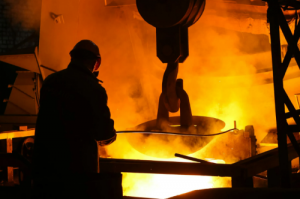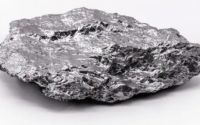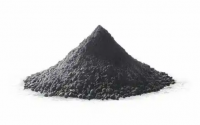July 19, 2024
List of Refractory Materials
Refractory materials are crucial for applications that require high-temperature resistance, durability, and chemical stability. Below are some common types of refractory materials, their specific use cases, and relevant data:

1. Oxide Refractories
- Alumina (Al2O3) is used in the linings of blast furnaces. With a melting point of 2072°C, it offers high thermal stability and resistance to slag attack. It is employed in the construction of electric arc furnace roofs due to its resistance to thermal shock and high-temperature strength.
- Zirconia (ZrO2) is employed in thermal barrier coatings for jet engines. It has a melting point of 2715°C, low thermal conductivity, and excellent resistance to thermal shock. Zirconia is used to coat turbine blades in jet engines to protect them from high operational temperatures.
- Magnesia (MgO) is utilized in cement kilns and steelmaking furnaces. It boasts a melting point of 2852°C, high chemical stability, and resistance to basic slags. Magnesia is used in the lining of basic oxygen furnaces in steel production due to its ability to withstand high temperatures and corrosive environments.
- Silica (SiO2) is used in glassmaking crucibles. It has a melting point of 1713°C and high thermal shock resistance. Silica is employed in the manufacture of glass because it can withstand repeated heating and cooling cycles.
- Chromite (FeCr2O4) is applied in the production of stainless steel. With a melting point of approximately 2180°C and good thermal stability, chromite is used in the linings of steel-making furnaces due to its resistance to thermal shocks and corrosion.
Related reading: 13 Types Of Refractory Materials And Their Applications
2. Carbide Refractories
- Silicon Carbide (SiC) is employed in high-temperature furnace linings. It has a melting point of 2730°C, high thermal conductivity, and excellent thermal shock resistance. Silicon carbide is used in kiln furniture for ceramic production, providing support for ceramics during firing.
- Boron Carbide (B4C) is utilized in abrasive materials and armor. With a melting point of 2763°C, it is one of the hardest known materials. Boron carbide is employed in ballistic armor for military vehicles and personnel due to its hardness and lightweight properties.
3. Nitride Refractories
- Silicon Nitride (Si3N4) is used in high-performance cutting tools. It has a melting point of 1900°C, high strength, and excellent thermal shock resistance. Silicon nitride is employed in bearings and turbine blades for its ability to maintain strength at high temperatures.
- Boron Nitride (BN) is applied in high-temperature crucibles. It has a melting point of 2973°C (sublimes) and excellent thermal conductivity. Boron nitride is used in components requiring good thermal conductivity and electrical insulation, such as semiconductor manufacturing.
4. Non-Oxide Refractories
- Graphite (C) is utilized in electric arc furnace electrodes. With a sublimation point of 3915°C, it offers excellent thermal and electrical conductivity. Graphite is used in crucibles for melting metals due to its high thermal conductivity and resistance to thermal shock.
- Molybdenum Disilicide (MoSi2) is used in heating elements. It has a melting point of 2030°C and good oxidation resistance. Molybdenum disilicide is employed in electric heating elements for high-temperature furnaces.
5. Composite Refractories
- Carbon-Carbon Composites are used in aerospace applications. They have high thermal conductivity, high strength, and can withstand temperatures up to 3000°C in an inert atmosphere. Carbon-carbon composites are applied in the nose cones of rockets and re-entry vehicle thermal protection systems.
- Reinforced Ceramics are employed in high-temperature structural applications. They offer improved mechanical properties and high thermal stability. Reinforced ceramics are used in gas turbine engines for their ability to maintain structural integrity at high temperatures.
6. Specialty Refractories
- Tantalum (Ta) is utilized in high-temperature chemical processing. With a melting point of 3017°C and excellent chemical resistance, tantalum is used in laboratory equipment and chemical processing apparatus due to its resistance to corrosive environments.
- Tungsten (W) is used in the manufacture of filaments. It has the highest melting point of any metal at 3422°C. Tungsten is employed in incandescent light bulb filaments and rocket nozzles due to its high melting point and strength.
- Hafnium Carbide (HfC) is utilized in ultra-high-temperature environments. With a melting point of 3900°C, it has one of the highest melting points among known compounds. Hafnium carbide is used in space re-entry vehicle thermal protection systems for its extreme temperature resistance.
These specific cases and data highlight the versatility and importance of refractory materials in various high-temperature and corrosive environments, demonstrating their critical role in industrial and technological applications. For more information, please check Advanced Refractory Metals (ARM).
| Type | Material | Melting Point (°C) | Use Case |
| Oxide Refractory | Alumina (Al2O3) | 2072 | Linings of blast furnaces |
| Zirconia (ZrO2) | 2715 | Thermal barrier coatings for jet engines | |
| Magnesia (MgO) | 2852 | Cement kilns and steelmaking furnaces | |
| Silica (SiO2) | 1713 | Glassmaking crucibles | |
| Chromite (FeCr2O4) | 2180 | Production of stainless steel | |
| Carbide Refractory | Silicon Carbide (SiC) | 2730 | High-temperature furnace linings |
| Boron Carbide (B4C) | 2763 | Abrasive materials and armor | |
| Nitride Refractory | Silicon Nitride (Si3N4) | 1900 | High-performance cutting tools |
| Boron Nitride (BN) | 2973 | High-temperature crucibles | |
| Non-Oxide Refractory | Graphite (C) | 3915 | Electric arc furnace electrodes |
| Molybdenum Disilicide (MoSi2) | 2030 | Heating elements | |
| Composite Refractory | Carbon-Carbon Composites | 3000 | Aerospace applications |
| Reinforced Ceramics | High | High-temperature structural applications | |
| Specialty Refractory | Tantalum (Ta) | 3017 | High-temperature chemical processing |
| Tungsten (W) | 3422 | Manufacture of filaments | |
| Hafnium Carbide (HfC) | 3900 | Ultra-high-temperature environments |



